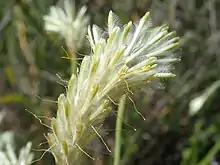| Ptilotus polystachyus | |
|---|---|
 | |
| Scientific classification | |
| Kingdom: | Plantae |
| Clade: | Tracheophytes |
| Clade: | Angiosperms |
| Clade: | Eudicots |
| Order: | Caryophyllales |
| Family: | Amaranthaceae |
| Genus: | Ptilotus |
| Species: | P. polystachyus |
| Binomial name | |
| Ptilotus polystachyus | |
| Synonyms[3] | |
|
Ptilotus alopecuroideus (Lindl.) F.Muell. | |
Ptilotus polystachyus (common name - Prince of Wales feather) is an herb in the Amaranthaceae family.[1]
Distribution
Ptilotus polystachyus is endemic to Australia and found in all mainland states, with the exception of Victoria.[4][3]
Taxonomy
It was first described in 1829 by Charles Gaudichaud-Beaupré as Trichinium polystachyum,[1][5] but was redescribed in 1868 by Ferdinand von Mueller as belonging to the genus, Ptilotus.[1][2]
References
- 1 2 3 4 "Ptilotus polystachyus". Australian Plant Name Index, IBIS database. Centre for Plant Biodiversity Research, Australian Government. Retrieved 1 November 2020.
- 1 2 Mueller, F.J.H. von (1868). "Amarantaceae". Fragmenta Phytographiae Australiae. 6 (49): 230.
- 1 2 "Ptilotus polystachyus (Gaudich.) F.Muell. | Plants of the World Online | Kew Science". Plants of the World Online. Retrieved 31 October 2020.
- ↑ "PlantNET - FloraOnline: Ptilotus polystachyus ". plantnet.rbgsyd.nsw.gov.au. Retrieved 31 October 2020.
- ↑ Gaudichaud-Beaupre, C. (1829), Voyage Autour du Monde ... sur les Corvettes de S.M. l'Uranie et la Physicienne. Botanique 11: 445